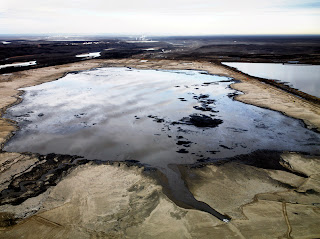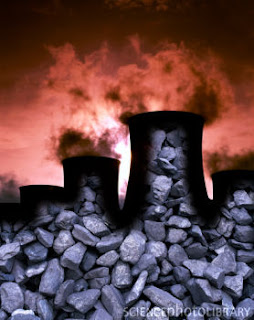Oil sands is a newer concept to the world, or at least it is newly being used starting over in Canada where it is available in abundance because of their soil. In an article from the Government of Alberta they compare oil sands to cold molasses when not treated and left at room temperature. Oils sands is a, “naturally occurring mixture of sand, clay or other minerals, water and bitumen, which is a heavy and extremely viscous oil that must be treated before it can be used by refineries to produce usable fuels such as gasoline and diesel”(GOA, 2011). Oil sands has close to the same process are renewable resources like biodiesel when it comes to making it useable for the general public. Oil sands has to be processed before it is “turned into” useable petroleum oil for vehicles and so on.
There are 2 different ways that oil sands are collected. The most common way to collect oil sands is through surface mining, while in situ extraction is the other way it can be collected. Surface mining greatly disturbs the environment, by contaminating water sources, vast land clearing, and large released of air borne pollutants like sulfur oxides, nitrogen oxides, hydrocarbons, and many other fine particle matter that is very bad for human/animal lungs. These are only a few of the issues with surface mining, and we’ve only scratched the surface of the major problems with this industry and new energy source. In situ extraction is the second way oil sands are collected, and this way it more disruptive to the environment. In situ extraction is the deeper extraction of oil sands and is usually used when collection needs to go deeper than 150 meters. They use steam heat to extract the oil sand, which is somewhat better for the atmosphere but the main issue is the carbon footprint that is left with this kind of extraction. Surface mining is largely responsible for a problem of “tailing ponds”, which are bodies of water that are contaminated and highly toxic. Also, surface mining is said to use “4-6 times more fresh water withdrawal than in situ extraction”, according to Alberta’s Oil Sands article. In situ extraction is said to be the growing method of oil sands extraction, but yet it is also damaging and highly hazardous to the environment. There are more major issues here with both methods of extraction of oil sands, and the biggest issue is that this industry and it’s benefactors have NO idea what the LONG TERM effects of oil sands drilling and surface mining will have on the environment and overall health of living organisms, i.e. humans, animals, etc.

The Alberta Environment, and more specifically, Environment Canada is the main environmental regulatory agency in Canada. Alberta Environment is an off-shoot of the main agency, Environment Canada which monitors gases at the oil sands operations. The gases that this agency monitors are sulfur oxides, nitrogen oxides, hydrocarbons, and PM. The main group that seems to be covering up the major impact that these pollutants are having on the environment are the RSC. Shockingly enough the RSC are actually the Royal Society of Canada, so you would think they would be a little more worried about what oil sands drilling is doing to their country, but then again they are more interested in the money they are profiting from this new energy. Despite the realization of the air pollutants that are being released into the atmosphere, they are seriously continuing on this path without understand the future consequences.
The biggest issue that I am foreseeing with this “new” energy is that there is really no push for conservation. This is just another avenue for energy that is not green and does not help the environment and clearly we are still looking for an EASY WAY OUT. Oil sands is just another type of fossil fuel that will still negatively impact the environment and is in no way a renewable resources that will be better for our world in the future. Conservation is not a part of oil sands mining or extraction because both methods are harming the environment through deforestation, air pollution, and water pollution. HUGE PROBLEMS! In no way is “conservation” a part of the oil sands industry because it is having the same environmental impact on our world as the petroleum industry is. Oil sands is NOT renewable, and is NOT environmental friendly so no, this does not help the conservation movement, it is hurting it. The conservation movement is in serious trouble is we allow oil sands to be the next type of energy source because we are being counterproductive towards of goal of renewable energy and less dependency on fossil fuels. Sadly, there will be NO conservation movement if oil sands is allowed to continue and become a large source of energy. We will be using this “new” energy source as a crutch to our lack and lessen amount of petroleum available. Also, since oil sands is seemingly a money making source of energy, it will be hard to stop it if something is not done SOON! There are major environmental issue with oil sands, and some of them are not even known yet which is another reason this energy should not be a replacement to petroleum. There will be a LARGE conservation impact if oil sands is continued to be extracted because large areas of land will still be deforested, water sources will be contaminated, and air will still be polluted.
Overall, oil sands is not a good idea and not studied enough YET for it to be already making head way and being considered as a useable energy in the future. If we are looking for a way to make renewable energy work, and be less harmful to the environment then we need to stop and think about this before we continue on. The biggest problem with this whole idea is the amount of support it seems to get without know the possible hazards and risks to the earth and its inhabitants. There is mixed information about what oil sands is doing to the environment and living beings in Canada, let alone if it’s reaches will expand if it becomes a bigger industry. If you are endangering humans, animals, and the environment you should have a better idea of what the effects are on ALL, and it is shocking to me that Canada doesn’t really have any concrete answers as to what the oil sands industry is doing. The industry doesn’t want to admit that the methods they are extracting and mining oil sands is harming the atmosphere with releasing of pollutants that are harmful long term on humans and the earth. They also don’t want to open their eyes and realize that they are polluting huge water sources and harming humans and animals in the process. Also, there are huge areas of forest that are being cut down to make way for mining oil sands and that is counterproductive toward the green future we need! Oil sands, regardless of whether or not they are surface mined or in situ extracted they are harmful to the environment. Furthermore, if the world is trying to be greener and focus more on renewable resources then oils sands is just a DISTRACTION and will not help our future, it will harm it. More research needs to be done if anything should continue with the oil sands industry, but I feel we should slow down and think about all of this before anything major is done, of anything further is done.
Resources
“What is Oil Sands?”. Government of Alberta, 1995-2011. Web. 16 Nov. 2011.
http://www.energy.alberta.ca/OilSands/793.asp
"Alberta’s Oil Sands: Hard Evidence, Missing Data, New Promises." News: Spheres of Influence. 3rd. 119. Environmental Health Perspectives, 2011. Print.












